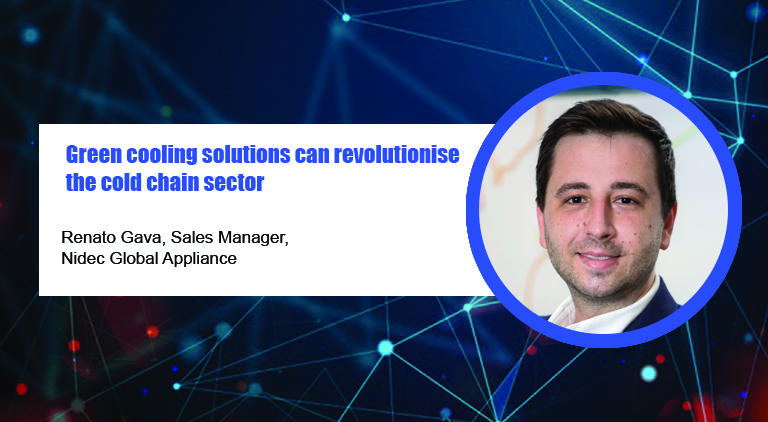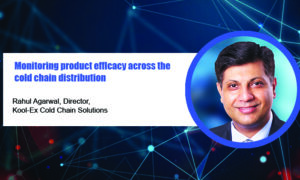Renato Gava, Sales Manager, Nidec Global Appliance, in an interview with TCBU Magazine, discuss ways to minimise the environmental impacts of cold chain by adapting 0 ozone depletion potential (ODP) and low-GWP refrigeration technologies.
How are the present global trends impacting your business?
Global trends have been tremendously impacted by the Covid 19 pandemic, and some of them have a great impact on our business. One global trend that has arised in consumer behavior in the context of the coronavirus pandemic is what is being called “cocooning”. The name refers to the habit of staying more at home, which became a necessity since March 2020 with lockdowns, and it has made people take a better look at their homes, and what their households could offer them. It made people invest in products both practical and comfortable, such as new appliances that would facilitate their lives.
Among other products, Nidec GA provides Embraco refrigeration solutions for most of the major home appliances manufacturers worldwide, so we are an important partner to attend this trend with innovative and high performance products that save energy, have lower noise, and less environmental impact.
Another global trend is the increased concern, by people and governments, about sustainability around the world. Transposing it to our business, we see the potential to boost the attention towards sustainable solutions for home and commercial appliances and, for us, it is as a great opportunity because for many years we have been investing in research and development (R&D) to offer the most energy efficient compressors and condensing units, and to foster the use of natural refrigerants in Embraco refrigeration solutions. It is great to see the global market moving now at a faster speed towards a direction that we have seen some years ago, of more sustainable solutions.
Another aspect is the digital revolution. The concept of digitisation was leveraged with accelerated speed in 2020 and we can see the reflex of it in our lives as individuals and in the economic and consumption dynamics. It impacts our business from the inside and outside. Inside we invest in process automation, digitisation of processes, RPA (robotic process automation) and many Industry 4.0 tools.
How is industry dealing with the temperature-controlled and multi-commodity storage requirements for the pharma, F&B and pharma sector?
We deal with it by customising our approach and solutions according to each specific kind of application. There is a clear difference in terms of requirements and specifications for applications for food and beverage from medical and pharmaceutical use.
Even though F&B have robustness and reliability requirements, medical and pharmaceutical product criteria are much higher, demanding tighter specifications to guarantee the system does not fail and that the goods temperature does not leave the mandated refrigeration range. These kinds of applications usually integrate robust cooling systems – using traditional brands that can offer the certified portfolio and years of expertise of operating in this market – with controls to guarantee the system is always on and has redundancies to prevent any failure, this way conserving the goods in the conditions they must be kept.
Beyond the traditional pharmaceutical applications we can highlight the ultra low temperature applications which operate in almost cryogenic conditions used for scientific use and including conservation of certain vaccines. These systems have a peculiar configuration called cascade, in which 2 refrigeration circuits are applied in series to reach these critical temperatures required for certain types of goods.
With the government’s push towards amplifying India’s cold chain industry, what kinds of opportunities do you foresee in India to revolutionise the cold chain sector?
We believe in the regulation of the cold chain, with defined specifications, and/or new energy labelling, which can favor the adoption of innovative and more technological solutions, as pathways to expand the cold chain footprint, while minimising the impact on current power grid.
Additionally, requiring more robust cooling solutions to deliver reliable cooling to the market minimises field failures or negative user experiences. We also consider that a further step in this openness and push from local government, is to incentivise the adoption of greener cooling solutions, applying refrigerants that have 0 ozone depletion potential (ODP) and low global warming potential (GWP) to minimise the environmental impact that a cold chain expansion could cause, while also adding extra energy efficiency. With this, the refrigeration supply chain (local and international) should bring to the Indian refrigeration industry these new solutions to allow the local OEMs (original equipment manufacturers) to pursue these objectives and integrate these innovative components to the installed base, generating and improving overall benefit.
Moreover, investment in Tier II and Tier III cities can drive development and expansion of the cold chain infrastructure to these regions, demanding production capacity to supply these regions and creating peaks of sales and installation, while improving significantly the quality of life of said places.
In short, we see the opportunity to develop a cold chain that is ready for the future, meaning an energy efficient and environmentally sustainable cold chain.
How is the industry planning to meet the vaccine storage and transportation challenges at Tier II and Tier III cities?
We manufacture the compressors and condensing units that power many of the equipment used in vaccine storage, but the logistics of vaccine storage and transportation is a know-how that belongs to our customers. What we can say is that Embraco is fully prepared to support customers with co-developments and products to assist this expanding market.
Apart from investments and storage what are the major challenges to be addressed? How is the industry moving ahead with them?
As mentioned in the answers above, the main challenges, besides investments, would be to develop capability and technology availability to support the local cold chain, either with local industries or imported technology. Another challenge is setting the internal targets that should be used to drive regulations and energy labelling proposals, in a way that the industry can support this without being weakened and without requiring too much investments from OEMs (the commercial and residential refrigerators manufacturers) and end users (food retail and food service businesses). The main path is to establish strategic partnerships within the supply chain, enabling the OEMs and, consequently the industry, to bridge this technology and sourcing gap in order to be prepared for the next wave of transformation and future challenges.
How has the pandemic impacted your sector’s growth?
Considering a global view on sales and customers, during the peak of the coronavirus pandemic, some projects were put on hold from February to June, due to production reduction in some customers, which are the residential and commercial refrigeration equipment manufacturers, as a result of the impact they suffered on sales. From July on, these projects have been resumed, especially those that contribute to a cost reduction in the customer’s production process.
From our side, we have restructured our projects’ pipeline and focused on accelerating solutions that deliver the same current technical requirements but add the standardisation and miniaturisation factors, in order to be more cost efficient for our customers.
Furthermore, the cold chain, a sector where we have a big presence with Embraco solutions for commercial refrigeration, has proved to be essential to quality of life in this context of a global pandemic. The industry needs to respond to a new way of living in which we see an increasing trend towards a healthier lifestyle. In this direction, food retail is being affected, which impacts the demand for refrigeration in the supermarkets, for example. However, it is the supply chain in the health sector that has shown a demand increase for reliable and robust refrigeration equipment, in order to properly preserve vaccines, blood banks and other medical items, avoiding the risk of jeopardising research or treatments.
__________________________________________________
We believe that regulation of the cold chain, with defined specifications, and/or new energy labelling, along with innovative solutions can amplify cold chain footprints in India.
Renato Gava, Sales Manager, Nidec Global Appliance
Cookie Consent
We use cookies to personalize your experience. By continuing to visit this website you agree to our Terms & Conditions, Privacy Policy and Cookie Policy.















